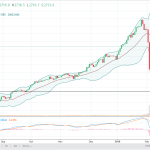The Office of the Comptroller of the Currency (OCC) reports that total gross notional derivatives contracts owned and outstanding by domestic banks rose for the second straight quarter. The OCC statistics are one quarter behind, meaning that though banks themselves are reporting Q3 numbers with earnings all figures shown here are from the official compilation for Q2. As such, the general trend was closer in line with “reflation” than in the most recent quarter, but clearly in transition from a more thorough embrace in Q1.
The increase in gross notionals fits with that characterization – a rise but still not much of one. The total for Q2 was $185 trillion across all types, up only 4% from $178 trillion in Q1. Year-over-year, however, gross notionals outstanding were still down 2.3%. It was the eleventh straight drop on those terms going back to Q3 2014.


A good part of the reason for the diminishing rebound is credit exposure, a method of bank and regulatory control (for an explanation on GPFV, NCCE, and netting, go here). Gross Positive Fair Value (GPFV) declined again in Q2 but only slightly as interest rates stopped rising overall.


Despite a lower GPFV since Q2 2016 (and the beginnings of “reflation”), Net Current Credit Exposure isn’t down by nearly as much. The reason appears to be some issue with netting, or more likely the capacity of dealers to be able to systemically offset their risks through opposite contracts, cash settlements, or collateral posted. The calculated netting benefit was in Q2 2017 the lowest since before the panic.

Unfortunately, the OCC report doesn’t give us any insight into why there might be so much difficultly netting at the same rates and levels as prior to the “rising dollar”, though in this case we aren’t out of line for reasonable speculation. I can’t help but notice the baseline correlation since 2014 between rising repo fails, hoarded dealer UST’s, and now the lower netted derivative exposures.














Leave A Comment